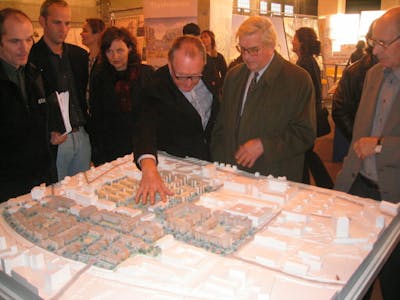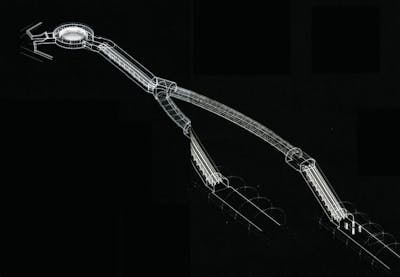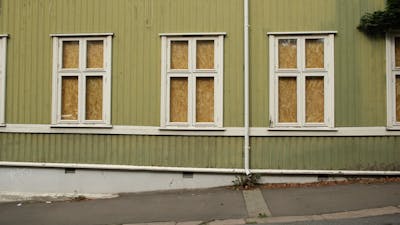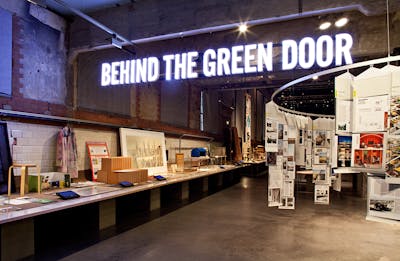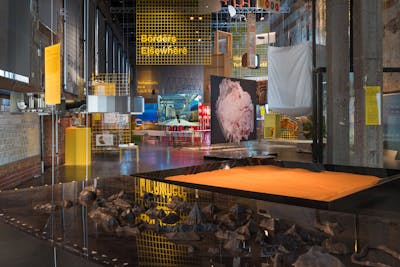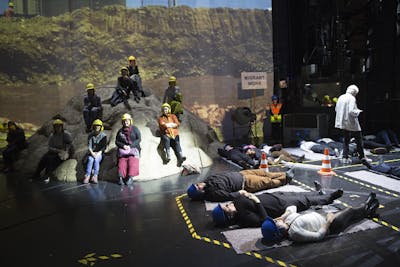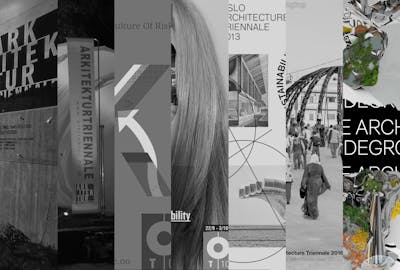BYENS LIVSFORMER
Scroll down for English
Min fremste relasjon til OAT er at jeg må kunne sies å være triennalens idémessige opphavsmann. Jeg satt i styret til Norske arkitekters landsforbund (NAL) i en periode ved tusenårsskiftet. NALs noe utydelige virke var for diffust og generelt. Organisasjonen gapte over litt for mange aktiviteter, i velmenende sosialdemokratisk ånd, tenkte jeg den gang. Min ideologiske motivasjon for å bli med var tre fanesaker: en internasjonal arkitekturtriennale, flere kvalitative arkitektkonkurranser og unge arkitekters fremtid.
Det skulle vise seg at det var den første saken jeg skulle bruke alt i alt rundt 2000 timer på, i tillegg til å drive min egen nystartede arkitektpraksis (en generøs takk til min familie herved).
Etter å ha tilbrakt tolv år borte fra min fødeby Oslo, hovedsakelig i utlendighet, føltes det provinsielt å flytte tilbake på siste halvdel av nittitallet. Den norske arkitekturdebatten om byen og urban utvikling virket på meg preget av 68’ernes selvforherligelse, slitne dogmer og moralske pekefingre. Denne velmenende generasjonen, som uten historisk sidestykke smidde samfunnet etter en rettferdighetsgestalt som gagnet dem selv mer enn noen andre.
I mangel av muligheter til å få oppdrag, begynte jeg å vandre langs markedets grøftekant og plukke opp oppgaver andre ikke ville ha. Samtidige duvet den foregående generasjon forbi i gilde farkoster, iført høyhalsede sorte gensere og markante arkitektbriller. Den dominerende debatten om byen var i stor grad tuftet på en sliten senmodernistisk moral om «den riktige rettferdigheten». For meg fremsto debatten som irrelevant og passé (mon tro hva de unge fremadstormende tenker om meg og min generasjon nå som vi er etablissementet?)
Etter mange år med arkitektstudier og praksis i Venezia, var internasjonale arkitekturbiennaler, kunstbiennaler og filmfestivaler blitt en naturlig del av mitt forhold til arkitektur, kunst og kultur. For venetianerne var arkitektur en del av livet og livet del i arkitekturen. Oslo fremsto som lite vital. Jeg savnet den faglige viraken og offentlige interessen. Ideen om en arkitekturtriennale i Oslo ble til en motivasjon for å bli med i NAL. Jeg tenkte at debatten rundt arkitektur burde tilhøre alle i samfunnet.
Ved å trekke internasjonale arkitektmiljøer til Oslo, ville vi få nye idéer, inspirasjon og nettverk. Kongstanken var å sette byens fysiske omgivelser på dagsorden med en nytenkende og mangfoldig agenda. Tanken ble til virkelighet. OAT #1 åpnet 15. september 2000: «Byens livsformer» var triennalens tema.
Noe av tidsånden bak den første triennalen fanges i et notat fra august 2000, der jeg skrev følgende styrende tekst (sitert i en lett redigert utgave):
OAT #1/2000 BYENS LIVSFORMER
ARKITEKTUR
uttrykker bruk og behov. Individer, familier, husholdninger,
interessegrupper, samfunn og nasjoner frembringer menneskenes mange
livsformer. Utvikling av byen må ivareta mangfoldet. Morgendagens by må
inneholde ROM for både individuell og kollektiv identitet.
Begrepet livsformer er valgt fordi det skal uttrykke noe generelt
og overgripende. På samme måte som ‘omgivelser’ er en generell
betegnelse på de fysiske strukturer som livet foregår innenfor, og er
omgitt av, er ‘livsformer’ ment som en betegnelse for hvordan livet
leves. Betegnelsen er altså ikke bare knyttet til boligsituasjon og
fritid, men omfatter også hvordan hele samfunnets produksjon og
utveksling skjer.
Tema for den første Triennalen vil være omstillingsproblemene som
bysamfunnet i dag står overfor. Endringer i teknologi, internasjonal
økonomi og rammeforutsetningene for å utøve politikk, skaper nye
betingelser for å formgi omgivelser. Dette viser seg i dag tydeligst i
bysamfunnene - i produksjon og organisering av næringsliv og i
kulturelle og sosiale endringer. Arkitektur er tolking av våre
livsformer.
Denne typen problemstillinger, smed ulik fokusering, står alle
større bysamfunn overfor, med ulike tilnærminger. Den europeiske byen
bærer med seg tradisjonsrike verdifull tradisjonell europeisk bykulturer
som stadig stilles overfor nye utfordringer. De nordiske byene
kjennetegnes av åpenhet og landskapsintegrering. Til samme tid er de
også sterkt preget av de velferds- og likhetsidealer som har
karakterisert nordisk politikk i de siste 50 årene.
Å løfte frem debatten rundt byens videre utvikling mener jeg har
stor verdi fordi den møter stadig nye utfordringer og byene får en
stadig større betydning. Diskusjonen i Norge har vært preget av
forenkling sett i forhold til den økonomiske, teknologiske og
sosiokulturelle kompleksitet som en utvikling av byen står i forhold
til.
På leting etter videre mulige utviklingsscenarier for byene
forvalter arkitektstanden viktig fagkunnskap som bør tre sterkere frem i
fokus.
Samtidsbyens tilstand er presist konstituert av det veldige kaos;
en fragmentert kompleksitet som inneholder et stort potensial for
videre utvikling, i mange forskjellige retninger. Den akselererende
globaliseringen skaper nye livsmønstre. Et økende omfang av
livsstilgenrer skaper nye behov som krever for en rikere artikulasjon,
innovasjon og bærekraftige løsninger i skjæringspunkter innenfor feltene
arkitektur og urbanisme.
Arkitektstanden bør være pådriver for å fremme nye muligheter i forhold til det økende mangfold.
Norge har mange utfordringer felles med de kontinental-europeiske
landene. Samtidig er den norske virkeligheten meget spesiell. Her
finnes ikke de akutte problemstillingene slik man ser i tette
demografiske områder i verden.
Befolkningstettheten på verdensbasis er ca. 40 personer per km2, mens den i Norge er 11 personer per km2.
All form for urbanisering i Norge relaterer seg visuelt til det
naturlige landskapet. Selv Osloregionen forblir en “by i skogen”. Denne
situasjonen med lav demografisk tetthet har forårsaket en skjødesløs
forvaltning av territoriet. Utbygging av de urbaniserte områder har ofte
skjedd etter overforenklede og tilfeldige fremgangsmåter.
…
De lokale og globale aspekter i byen påvirker vårt
sett å leve på. Behovene for kollektive referanser er konstante,
samtidig som individualitet innenfor det urbane rom stadig blir sterkere
som et resultat av eksisterende samfunnsmekanismer. Eksempelvis er det
tradisjonelle klare skille mellom hjem og jobb ikke lenger tydelig. Den
urbane strukturen må være i konstant utvikling for å kunne dekke et
økende spenn av både felles- og enkeltbehov.
Triennalen vil i sin første avvikling bli dedikert by-relaterte
tema i forhold til bestemte steder. Spesifikt vil det settes søkelys på
utviklingen av Oslo og potensialer for videre scenarier i forhold til
lokale og globale premisser.
I Triennalen settes søkelys på de byplan- og miljømessige
utfordringer hovedstaden står overfor gjennom presentasjon av scenarier
og visjoner som skal gi idéer, løsninger, forslag og innspill til den
videre utviklingen.
…
Utviklingen frigjør de arkitektoniske typologier, stadig
dukker nye hybrider opp, byens bilde endrer seg uavlatelig og i et
hektisk tempo. Oslo er ikke lenger symbolisert ved de gamle ikonene
Rådhuset og Holmenkollen. Utrolig mange strukturer inngår i arbeidet med
by formingen, og denne pluralisme er det vi forsøker å gripe fatt i og
gjøre til en kreativ ramme for den første Arkitekturtriennalen.
Hva tenker jeg tyve år etter?
OAT
#1/2000 BYENS LIVSFORMER ble en fantastisk manifestasjon. Mange
enkeltmennesker og organisasjoner bidro med stor pasjon for denne første
triennaleavviklingen. Åpningen og konferansen var helt full og bar preg
av at noe nytt var i ferd med å skje i arkitektur-Norge. Selve
utstillingsdelen utgjorde det store løftet. Denne ble avholdt i et 400
meter langt tilfluktsrom under Nasjonalteateret stasjon. Man viste at et
av byens mange ukjente rom kunne brukes til flerfoldige aktiviteter og
at potensialet ved å utvikle nye strategier åpner for nye perspektiver
og muligheter. Mange unge norske arkitektkontorer bidro med faglige
nytenkende innspill og prosjekter. I tillegg ble det invitert et knippe
med utenlandske team som Kazuyo Sejima + Ryue Nishizawa, MVRDV, Studio
Rier Luigi Nicolin. Disse fikk i oppgave å utforme prosjekter og urbane
strategier for hvordan Oslo kunne vokse og utvikle seg til en god
fremtidsrettet by å leve i. Utopier og realisme ble knyttet sammen i en
mangfoldig vev av muligheter. For meg utgjorde triennalen den gang på
mange måter et vannskille i hvordan jeg så på Oslo.
I dette tyveårsperspektivet burde man tatt med seg flere av de
interessante tankene som kom opp. Innenfor boligsektoren har vi spesielt
sett mange tapte muligheter. Den byggede boligmassen avspeiler ikke
byens mangfold av etterspørsel. Politikere, offentlige byplanleggere og
utbyggere har vist liten evne til nytenkning innenfor boligarkitekturen.
Både den offentlig og private sektor må i større grad se på muligheten
for å utvikle nytenkende boformer, boligtypologier og nabolag der
helhetstenking har vært vektlagt.
Har OAT en berettigelse?
I
mine øyne er det viktig å eksperimentere mer. Samfunnets evne til å
utvikle arkitektur har i for stor grad blitt preget av juridisk
systemtenkning der man belønner det middelmådige, preaksepterte og
overfladiske. Juristen bør ikke være den som setter kriteriene for hvem
som er god nok arkitekt og hvordan man utvikler gode prosjekter.
Begrepet kvalitetssikring har i dag mer med feilsøking å gjøre, enn
med å virkelig utvikle kvalitet og sikre denne. Vi trenger en kritisk,
utprøvende, eksperimentell og fargerik arena som OAT.
«Skal humanismen gå i idealismens glemmebok?» spør Lars Saabye Christensen i sitt siste verk Byens Spor.
Alle snakker om bærekraft, men dette politisk korrekte tvangsordet
fremstår veldig hult. Det er ikke tvil om at keiserens nye klær
fremdeles er på moten. Når jeg ser meg rundt i Oslo, skjelner jeg mange
lettkjøpte konsensusholdninger, og grønnvasking med høy faktor har
virkelig frembrakt mange elendige byggverk. Noen av de mest omtalte
«bærekraftige» byggverkene fremstår som dårlig og sosialt uempatisk
arkitektur. Å skape gode arkitektoniske levekår i bærekraftig utforming
er krevende. Samfunnets ønske om bærekraftighet omfatter både fysiske
strukturer, mentale møteplasser og private rom som utformes med kløkt
tuftet på kvalitetstenking. Vi trenger å ta omgivelsene mer på alvor for
alle levende arter. Vi trenger mer empati, mer toleranse, mer tvil, mer
mangfold.
WAYS OF LIVING
Text by Reiulf Ramstad
My foremost connection with
the Oslo Architecture Triennale (OAT) is that I can claim to be its
conceptual author. For a period of time around the turn of the
millennium I sat on the board of the National Association of Norwegian
Architects (NAL). NAL’s somewhat unclear activities were too diffuse and
general. My impression at the time was that the organization, in the
well-intended spirit of social democracy, bit off a little more than it
could chew in terms of activities. My ideological motivation to join NAL
was based on three main concerns: an international architecture
triennale, more qualitative architectural competitions, and the future
of young architects.
As time would show, I was to spend a total of about 2000 hours on the
first of these causes, in addition to running my own newly started
architecture practice (herewith a heartfelt thanks to my family).
Having spent twelve years away from Oslo, mainly abroad, my return to
the city in the latter half of the nineties felt provincial. The
architectural debate in Norway about cities and urban development seemed
to be dominated by the self-glorifying generation of ‘68, worn-out
dogmas, and moral reproof; a well-intentioned generation that without
historical precedent forged society according to its own sense of
righteousness, benefitting themselves more than anyone else.
In the absence of opportunities for commissions, I started to pick up
assignments others did not want. At the same time, the previous
generation with their black polo-neck sweaters and conspicuous architect
glasses drifted past in flashy automobiles. The dominant debate about
the city was largely founded on the stale late-modernist ethic of
‘proper justice’. To me, the debate seemed irrelevant and passé (but I
wonder what the young and aspiring think about me and my generation, now
that we are the establishment?)
After many years of studying and practicing architecture in Venice, a
natural part of my relationship with architecture, art and culture
involved international architecture biennials, art fairs and film
festivals. For the Venetians, architecture was a part of life, and life
was enmeshed with architecture. Oslo appeared to be a city of little
vitality. I was missing the professional bustle and public interest. The
notion of an architecture triennale in Oslo motivated me to join NAL. I
felt that the debate about architecture should belong to all of
society.
By attracting international architectural communities to Oslo, we
would gain new ideas, inspiration and networks. The central idea was to
spotlight the city’s physical environment with an innovative and
diversified agenda. The idea became a reality. OAT #1 opened on 15
September 2000. The theme of the Triennale was ‘Ways of Living’.
Some of the spirit behind the first Triennale is captured in a note
from August 2000, in which I set out the following guidelines (slightly
revised):
OAT # 1/2000 WAYS OF LIVING
ARCHITECTURE
expresses need and use. Individuals, families, households, interest
groups, societies and nations foster many different ways in which human
beings live. Urban development must safeguard this diversity. Tomorrow’s
city has to incorporate SPACE for both individual and collective
identity.
The phrase ‘ways of living’ has been chosen in order to express
something general and overarching. Just as ‘sourroundings’ is a general
term for the physical structures in which life takes place and by which
it is framed, ‘ways of living’ is intended as a term denoting how life
is lived. This means that the term not only relates to housing
situations and leisure activities, but also encompasses the ways in
which production and exchange take place throughout society.
The theme of the first Triennale will focus on the restructuring
issues faced by urban societies today. Changes in technology, the
international economy and the general framework underlying political
policy create new conditions for shaping the environment. Today, this is
most evident in urban communities – in the production and organization
of businesses and in the changes affecting cultural and social arenas.
Architecture is the interpretation of our ways of living.
All larger urban communities face these types of issues, with
varying focus and various approaches. European cities represent valuable
traditional urban cultures that are increasingly faced by new
challenges. Nordic cities are distinguished by openness and landscape
integration. At the same time, they are also strongly shaped by the
ideals of welfare and equality that have characterized Nordic politics
over the past 50 years.
Raising the debate about the future of urban development is of
great value, I believe, because cities are constantly facing new
challenges and are becoming increasingly important. In Norway, the
discussion has been characterized by an oversimplification in relation
to the economic, technological and socio-cultural complexity associated
with urban development.
In the search for possible future development scenarios for our
cities, the architectural community is able to draw on important
expertise that should come into stronger focus.
The current state of our cities is, if anything, distinguished by
a tremendous chaos; a fragmented complexity that offers great potential
for future development, in many different directions. Globalization is
accelerating and creating ever new life patterns. A widening spectrum of
distinct lifestyles entails new requirements that demand richer
articulation, innovation and sustainable solutions in the intersection
between the fields of architecture and urbanism.
The architectural community should be a driving force in promoting new opportunities in connection with the growth in diversity.
Norway shares many of the challenges faced by continental
European countries. At the same time, Norwegian reality is quite unique.
Here, we are not confronted with the acute issues that can be seen in
densely populated areas in the world. While the global population
density is approximately 40 people per km2, that of Norway lies at 11
people per km2.
In Norway, all forms of urbanization relate visually to the
natural landscape, and even the Oslo region remains a ‘city in the
woods’. This low demographic density has led to careless management of
the territory. The development of urbanized areas has often been based
on oversimplified and random methods.
…
The local and global aspects of the city affect the
way in which we live. There is a constant need for collective
references, while individuality within the urban space at the same time
becomes increasingly more pronounced as a result of existing social
mechanisms. For example, the traditionally clear distinction between
home and work is no longer unambiguous. The urban structure must be in
constant development to be able to fulfil the increasing range of both
communal and individual needs.
In its first implementation, the Triennale will be dedicated to
city-related topics tied to particular locations with specific focus on
the development of Oslo and the potential for future scenarios in
relation to local and global premises.
The Triennale will spotlight urban planning and environmental
challenges facing the capital by presenting scenarios and visions
designed to spawn ideas, solutions, proposals and input for further
development.
…
Development leads to the liberation of
architectural typologies; new hybrids are constantly emerging, the
cityscape is changing perpetually and at a hectic pace. Oslo is no
longer epitomized by former icons such as City Hall and Holmenkollen.
Work on urban design involves innumerable structures, and it is this
pluralism we are attempting to address and utilize as a creative
framework for the first Oslo Architecture Triennale.
What do I think twenty years later?
OAT
#1/2000 WAYS OF LIVING materialized into an extraordinary event. Many
individuals and organizations contributed with great passion to
facilitate this first Triennale. The opening and the conference were
filled to capacity and revealed that something new was about to happen
in Norwegian architecture, with the main exhibition being the core
attraction and force. It was held in a 400-meter long shelter beneath
Nationaltheatret railway station. This made it possible to show that one
of the city’s many unknown spaces could be used for numerous
activities, and that the development of new strategies opens up the
potential for new perspectives and possibilities. Many young Norwegian
architecture firms contributed with innovative professional input and
projects. In addition, a small number of foreign teams were invited,
including Kazuyo Sejima + Ryue Nishizawa, MVRDV, and Pierluigi Nicolin.
These were given the task of designing projects and urban strategies for
Oslo to grow and develop into a forward-looking city with a good
quality of life for its citizens. Utopias and realism were united in a
diverse web of possibilities. For me at the time, the Triennale in many
ways represented a turning point in how I viewed Oslo.
Has OAT #1 had any effect?
This
is not easy to ascertain, of course, but the Triennale undoubtedly
helped ignite some sparks of enthusiasm and innovative thinking for the
future development of the city. Oslo has become a richer, more diverse
city to live in. Undoubtedly, there have been many positive changes in
our city, although major challenges remain on the horizon, both locally
and globally. The general culture is infiltrated by local and global
trends. Oslo has gained faith in its ability to grow into a medium-sized
European city with all the qualitative advantages of an urban culture.
Furthermore, it was not exactly a disadvantage that this period was
characterized by an exceptionally strong economy. In 2020, the
increasingly recognized World Happiness Report has ranked not only
countries, but also cities. Here, Oslo is positioned as one of the
world’s best cities to live in. I shall be careful to specify the degree
to which the Triennale has been a concrete factor, but one can assume
that it has been a positive aspect for many professionals during these
twenty years.
A number of the interesting ideas that arose in this 20-year
perspective should have received more consideration. The housing sector
in particular has sustained many missed opportunities. The aggregate
housing stock does not reflect the city’s diverse demands. Politicians,
government planners and construction companies have shown little
willingness for innovation when it comes to residential architecture.
Both the public and the private sector must take a closer look at the
prospect of developing more innovative forms of housing, housing
typologies and neighbourhoods with an emphasis on holistic thinking.
Does OAT have legitimacy?
In
my view, it is important to experiment more. The ability of society to
develop architecture has been far too prone to systemic legal thinking
that rewards mediocrity, entrenched views and superficial thinking.
Lawyers should not be the ones to determine the criteria for who is a
good enough architect and how to develop quality projects.
Today, the concept of quality assurance has more to do with
troubleshooting than with the actual development of quality and its
safekeeping. We need a critical, experimental, exploratory and diverse
arena such as OAT.
‘Will humanism sink into the oblivion of idealism?’ asks Lars Saabye Christensen in his latest novel Echoes of the City.
Everyone talks about sustainability, but this politically correct
verbal straitjacket appears to be quite hollow. There is no doubt that
the emperor’s new clothes are still in vogue. When I take a look around
Oslo, I see many run-of-the-mill solutions based on consensus, and many
truly dreadful buildings are the result of greenwashing of the highest
order. Some of the most talked about ‘sustainable’ constructions stand
out as poor and socially indifferent architecture. The creation of good
architectural living conditions with a sustainable design is a demanding
task. Society’s desire for sustainability includes both physical
structures, mental meeting places and private spaces designed with a
view to quality. We need to take our environment more seriously for all
living creatures. We need more empathy, more tolerance, more doubt, and
more diversity.
English translation: Thilo Reinhard
